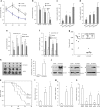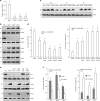Induction of tumor apoptosis through a circular RNA enhancing Foxo3 activity
- PMID: 27886165
- PMCID: PMC5299715
- DOI: 10.1038/cdd.2016.133
Induction of tumor apoptosis through a circular RNA enhancing Foxo3 activity
Abstract
Circular RNAs are a class of non-coding RNAs that are receiving extensive attention. Despite reports showing circular RNAs acting as microRNA sponges, the biological functions of circular RNAs remain largely unknown. We show that in patient tumor samples and in a panel of cancer cells, circ-Foxo3 was minimally expressed. Interestingly, during cancer cell apoptosis, the expression of circ-Foxo3 was found to be significantly increased. We found that silencing endogenous circ-Foxo3 enhanced cell viability, whereas ectopic expression of circ-Foxo3 triggered stress-induced apoptosis and inhibited the growth of tumor xenografts. Also, expression of circ-Foxo3 increased Foxo3 protein levels but repressed p53 levels. By binding to both, circ-Foxo3 promoted MDM2-induced p53 ubiquitination and subsequent degradation, resulting in an overall decrease of p53. With low binding affinity to Foxo3 protein, circ-Foxo3 prevented MDM2 from inducing Foxo3 ubiquitination and degradation, resulting in increased levels of Foxo3 protein. As a result, cell apoptosis was induced by upregulation of the Foxo3 downstream target PUMA.
Conflict of interest statement
The authors declare no conflict of interest.
Figures








Comment in
-
Roles of the circular RNA circ-Foxo3 in breast cancer progression.Cell Cycle. 2017 Apr 3;16(7):589-590. doi: 10.1080/15384101.2017.1278935. Epub 2017 Feb 25. Cell Cycle. 2017. PMID: 28278047 Free PMC article. No abstract available.
References
-
- Haimovich G, Medina DA, Causse SZ, Garber M, Millan-Zambrano G, Barkai O et al. Gene expression is circular: factors for mRNA degradation also foster mRNA synthesis. Cell 2013; 153: 1000–1011. - PubMed
-
- Zhang XO, Wang HB, Zhang Y, Lu X, Chen LL, Yang L. Complementary sequence-mediated exon circularization. Cell 2014; 159: 134–147. - PubMed
MeSH terms
Substances
Grants and funding
LinkOut - more resources
Full Text Sources
Other Literature Sources
Research Materials
Miscellaneous

